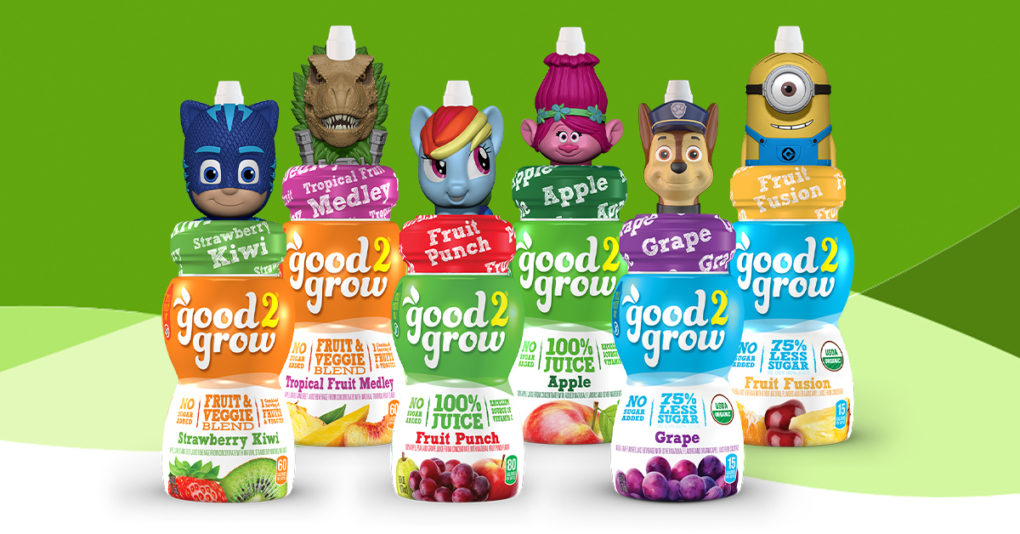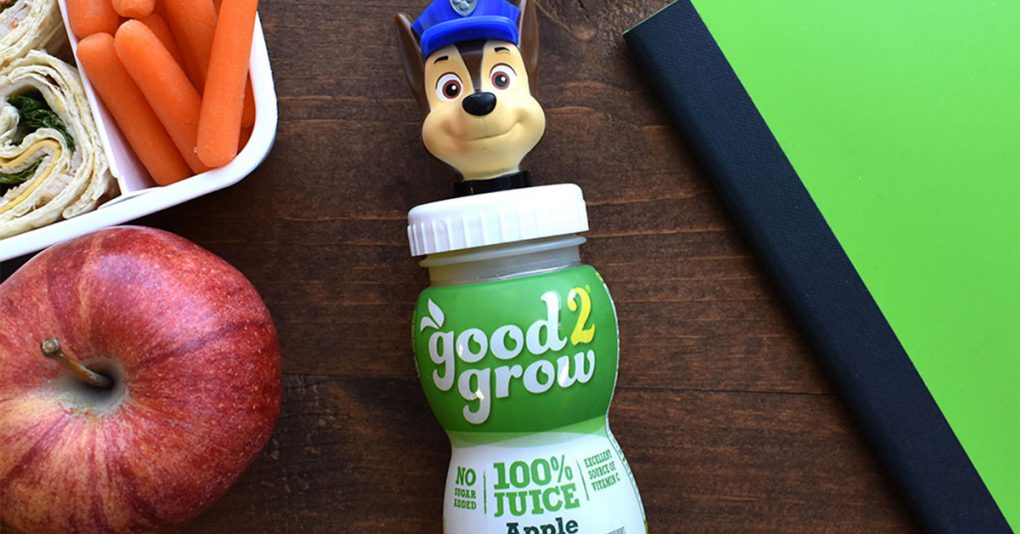As CEO Gunnar Olson puts it, good2grow doesn’t compete for share of stomach, it competes for share of eyeballs.
The nearly 26-year-old kids beverage and snack brand – which makes juices, milks and, as of last year, crackers – is distinctive for its IP-driven bottle tops, which feature characters ranging from Mickey Mouse to Sonic the Hedgehog, building its business largely off of impulse purchases by hitting the dual use case of refreshing drink and shiny new toy for young children.
Now, three years after its sale to private equity firm Wind Point Partners, good2grow is growing up fast. Speaking to BevNET last week, Olson said that over the last five years, the brand has expanded its household reach over 50% – to around 28 million in the U.S. – and is now among the top juice brands in the convenience and large format channels such as mass, grocery and dollar.
According to Circana, sales of good2grow’s bottled fruit drinks were up 11.3% to over $170.8 million in MULO and c-store accounts in the 52-week period ending July 14, fifth overall in the segment behind just Snapple, Hawaiian Punch, Sunny Delight and AriZona. The brand’s bottled apple juices were down slightly by -0.1% to around $120.3 million in the same period (number three in the segment after private label and Mott’s) and bottled fruit juice blends dipped -0.9% to $102.8 million (number one for the segment, beating out Juicy Juice). Its RTD milks were up 60.8% to $17.9 million.
Although those numbers make up a sizable portion of the brand’s sales, they don’t include all channels or product lines, including the snacks.
Convenience remains a pivotal channel for good2grow, Olson said, estimating that it accounted for roughly 40% of the brand’s total business. However it’s the large format retailers that are growing the fastest as those stores “lean more heavily into the display concept” with front end caps and highly-trafficked checkout placements.
About half the households now in good2grow’s fold, Olson added, don’t have kids in them but are instead adults buying the drinks for others such as grandchildren, nieces and nephews, or the kids of friends.
“I don’t want to say that all we require is traffic, but that is kind of all we require,” he said. “Because we aren’t necessarily a juice trip or a beverage trip – we’re a treat.”
Manufacturing the Impulse
In-store merchandising is important for any brand’s success, but with good2grow, securing the right placements with as large an assortment of SKUs as possible is paramount.
As impulse buys drive a significant portion of all good2grow’s sales, Olson said the brand’s goal is to win wide displays that can showcase as many character bottle tops as possible, while also being at eye-level placement for children. At their best, a strong endcap display in a large format store can produce velocity multiples anywhere from 10x-15x, he added.
While cautioning that nothing is easy, Olson admitted that good2grow does have some advantages that other brands may lack when it comes to in-store placements. Where most adult beverage brands are vying for highly competitive fifth and sixth shelves in doors, good2grow’s sweet spot is the third shelf from the bottom.
“When we’re on any shelf, whether refrigerated or not, the key is being at a kid’s eye level,” he said. “If it’s on the top shelf, we’re done. There’s not many six-foot four-year-olds.”
Childrens’ interest in the drink’s toy factor and their less refined palates also mean that refrigeration is less important, Olson added, noting that the drinks maintain their flavor at room temp and that kids are less likely to be picky compared to adults about chilling the bottles before consuming.
“Kids do not care,” he said. “If you get a four-year-old that gets their hands on Bluey, they’re not going to ask their parents to chill it before they want to engage with it.”
Good2grow currently has licensing deals for over 350 different characters, including top IPs like Disney, Marvel, Paw Patrol, Bluey and Sega, just at the tip of the iceberg. Olson characterized the brand’s licensing and product assortment as the second most important part of the entire business, trailing only product safety on the list of priorities.
Much like PEZ before it, good2grow has benefited from the collectability of its bottle tops, and ensuring they have A-list characters and brands is another core pillar for creating a similar top level halo around good2grow.
“The easiest way to think about it is we want the very best of the very best, and we want to make sure that we’re rotating it in such a way that every single time a kid approaches the shelf there’s something new for them to see,” he said.
Olson said the company thinks of its character portfolio much like a stock portfolio, preferring long-game gains with properties that will be top sellers for years or decades and rarely ties its launches to tentpole events that could potentially turn out to be flash-in-the-pan moments or flops, though he admitted they may occasionally up the numbers of existing SKUs for a big movie release.
While some IPs may fade in popularity over the years (Olson declined to name names), he said others like Spider-Man and Mickey Mouse have proven perennial as Disney continues to reinvent the characters for young children.
The company is also exploring new innovations beyond IP designs. In 2021, good2grow added single-serve milks to its offerings and more recently added a larger 10 oz. Bigger bottle size for its juices, intended to help extend the reach with older kids.
Last year, good2grow extended beyond liquid and into food with its line of Snackers single-serve cracker packs, similarly featuring licensed character lids to appeal to children. Olson said the overarching strategy with the snacks remains the same as the beverages – focus on impulse sales with strong in-store displays and wide arrangements – but the line is now helping reach new consumers. He estimated around 40% of good2grow’s snack buyers have never tried the juice and is now delivering on a “crossover opportunity” to fuel incremental sales for both lines.
While there is opportunity to reach consumers in different sections of the store with the snacks, Olson noted that he does prefer to merchandise both snacks and drinks together, particularly in c-stores, however in large format the brand has been more open to the lines living in different sections of the store.
“I think it’s even surpassed our rather optimistic expectations,” he said. “We’re about at the point where we built this supply chain out to launch this very, very broadly, and we will continue to look to lean into food as well as beverage.”

